
Microcladia borealis
Coarse Sea Lace
Harling Point, Juan de Fuca Strait, British Columbia, Canada
27 September 2020
Observed for 102 minutes commencing at 7:07am PDT
Low Tide 3.0 feet at 07:15am PDT (measured at Oak Bay Point Tidal Station)
Weather: Mainly overcast, no precipitation, wind variable 0-5km/hour, sea smooth, temperature 11˚C, relative humidity 93%.
Phase of Moon: Waxing Gibbous (approx. 84 hours into this phase at time of observation); (Previous Phase, First Quarter, 23 Sept 2020 at 6:54pm PDT: Next Phase, Full Moon, 1 Oct 2020 at 2:05pm PDT.)
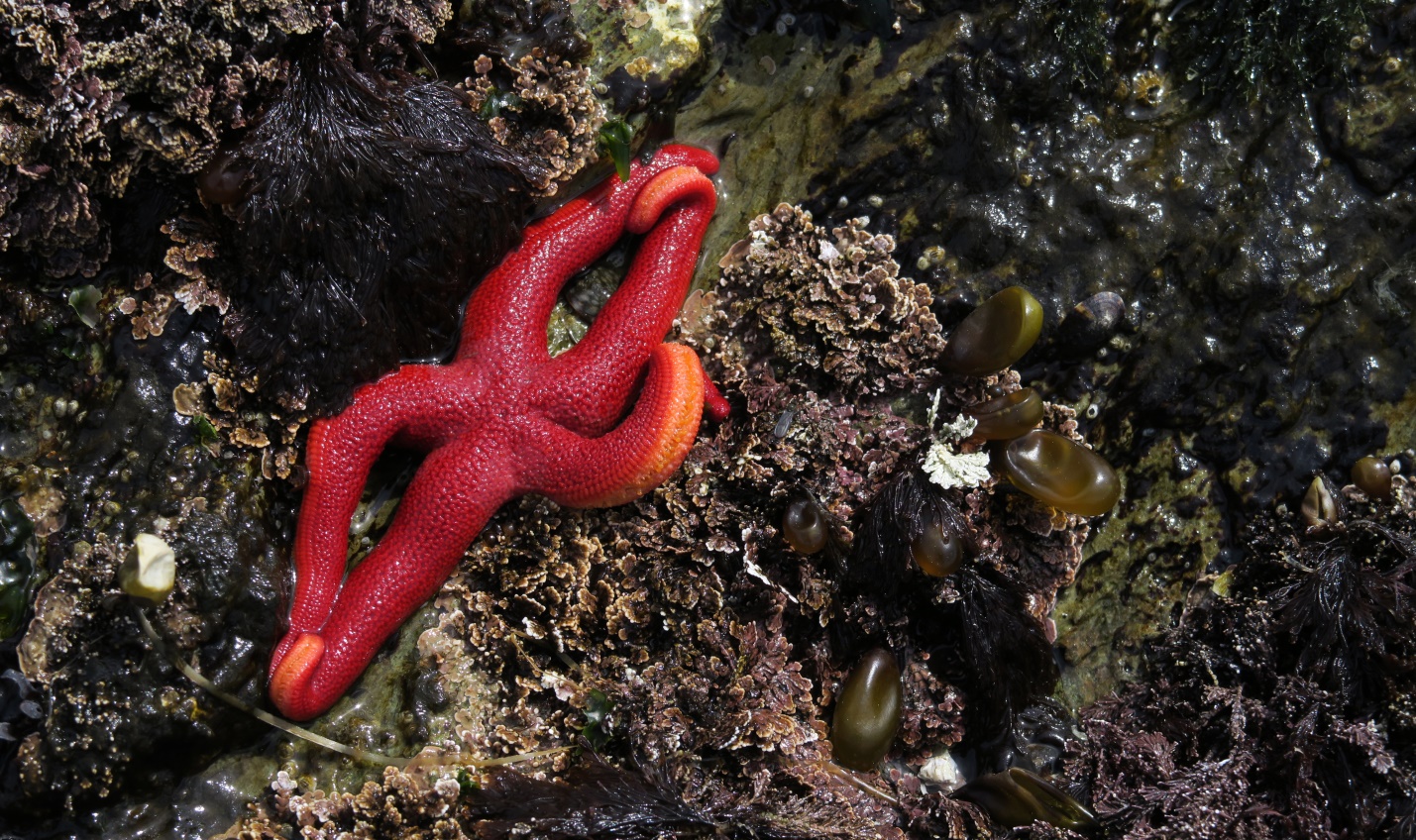
Figure 1: Microcladia borealis – a few dark sprays of Coarse Sea Lace are pictured here splayed out on the bedrock substrate at low tide. The blood star (Henricia leviuscula leviuscula), young Sea Sacs (Halosaccion glandiforme) and even the Graceful Coral Seaweed (Corallina vancouveriensis) attract ones attention such that one might easily overlook the Microcladia. Harling Point, Juan de Fuca Strait, BC, Canada. September 5, 2020. Photo ID 27167 ©Seaweedwhisperings.com
In-Situ Observations:
Observations were done in-situ. We interacted with the live seaweed in the mid intertidal zone; the seashore here is a place where igneous bedrock meets the ocean.
Dishevelled wet hair (appearance).
Wig – looks like hairdo that doesn’t belong, like a poor fitting wig; it’s not the being’s natural “hair”.
This seaweeds energy seems to involve self-entanglement.
Rougher feel than expected.
Pincers (close up) look like vice-grips.
Strong dark purple-y brown color.
Looks tough and wiry up close. I was playing with it, curious to see what its reaction would be to trying to break it – and it snapped right off, cleanly.
Radiating in single plane. Many plants had a fan-like shape.
Vulnerable at the edges.
I sense that it is strong and confident in most of its bulk and in a single plane. However, when extending itself in the world, this seaweed is very uncomfortable and feels vulnerable. The “location” of this vulnerability/discomfort is at the edges and if forced out of the single plane into a third dimension.
I needed to inspect this seaweed up close; I couldn’t do it well from a distance. Out of that came the concept – introspective.
Had to look up close because it wasn’t giving anything out.
Resistant to predation and outside influences. Impervious?
Pincers to keep others away.
Crunchy texture (upon tasting).
Surprisingly un-salty taste.
Slight lettuce flavor.
Thinking about this seaweed’s name, Microcladia – small and clinging.
Borealis – brings to mind aurora borealis, ‘Northern Lights’.
Coarse Sea Lace – describes well the look and feel of this sea weed.
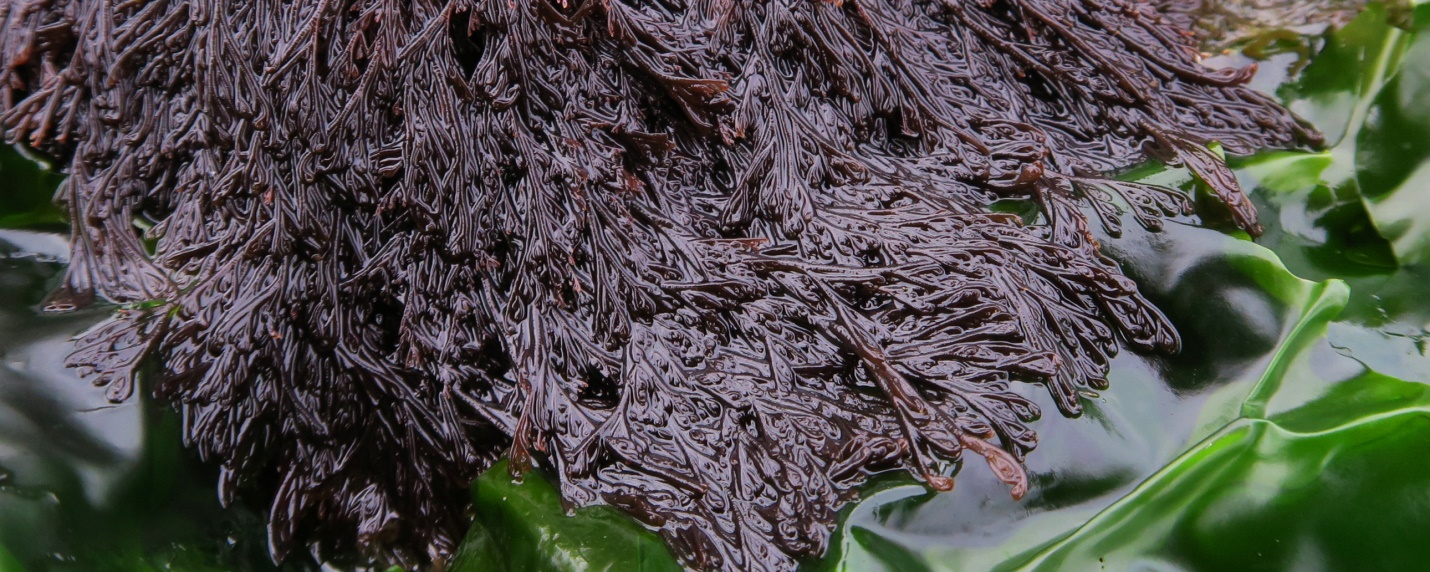
Figure 2: Microcladia borealis – forked “crab pincer” tips are visible on this closer view of Coarse Sea Lace; Harling Point, Juan de Fuca Strait, BC, Canada. August 31, 2020. Photo ID 27168 ©Seaweedwhisperings.com
Person 2:
This morning there is a sunrise of pinks and golds against the mauve and charcoal grey clouds; opposite this display of glorious color the sky is lit with a full rainbow.
Light of all kinds and colors, too!
This felt very special, and the light from the sky, it was mirrored in the puddles and patches of seawater around and amongst the seaweeds. For a lingering few minutes, the water at our feet was pink and mauve, also.
This seaweed looks like fans of dark, dark burgundy, fans with a small and intricate design, fans cascading down the bedrock here between the barnacles, corallinas, tar spots, sea sacs and ulvas.
The little branchlets of the seaweed lie flattened as if combed out.
You are not messy but neatly patterned.
The patterning, even if not closely examined gives a curved impression.
You descend, cascading towards the sea, in channels of spreading dark fans.
The color of this seaweed is so dark and its size is small enough, that the shape of it is difficult to discern. In fact, many times what you ‘see’ of it is mainly the light reflected back from between its many branchlets, not the shape and form of the seaweed itself.
A Common Loon cried now. I felt compelled to note this. It could be felt as a disturbance, but it wasn’t experienced as such; it felt like a gift - how beautiful the loon’s call is. Gulls are calling too, “where’s breakfast…, where’s breakfast?” A tide pool-hatched mosquito finds me as her own possible breakfast source.
Taking in my surroundings, close and far, with several of my senses – I wonder if Microcladia tends to do this too?
I now settle my attention back with Microcladia borealis.
Your fine pattern of tiny branches holds water. This water must serve to hydrate at low tide and it also reflects the light. The contrast between your own dark color and all these intricate patches of trapped water is what one sees when looking at you. It can be confusing, or a trick of perception, like a camouflage silhouette – what one sees is partly you and largely what is NOT you. The ‘negative space’ as artists call it, where the water lies, is lit up, reflects light, and attracts attention, and yet where the water lies is not you, but between your parts.
You lie flat, one might say limply and displaying little wilfulness, except for the pattern of your branches. With this pattern there is some ‘character’, a personality that identifies you.
When I lift a branch of this seaweed from where the outgoing tide has left it – the water falls away, and the tiny branches clump together in lighter brown tufts, not unlike some mosses of the forest floor (one that comes to mind is step moss, Hylocomium splendens ).
Your pattern of growth is interesting. Off of your stem most of the little branches happen near the end and where the branches do grow it is only to one side of your stem. The ends of your branches all tend to gently curl in a pleasing arch.
What does that give you?
Does it help you be more tangle-free?
Does it give you the ability to lie down more easily and more closely to the substrate where water will linger at low tide?
You are small – I want my hand lens to see you more clearly.
My, you actually are tiny! Details show up with magnification. Your branchlets at the tip form a fork with one side of the fork longer and curled over the other almost making a tiny clasp or pincer.
This adds to your overall impression – your ends are not pointed, not blunt, they are gracefully rounded, curled back in to yourself.
Curling in – at your leading edge, why?
Are you frightened and protecting yourself?
Are you weak and unable to stretch out strongly ahead?
Did you reach out, damage yourself, and retreat?
Are you simply ceding to some centrifugal force that has your wanderings restricted to the area only within some invisible barrier?
Are you prepared to grasp something, or are you already grasping it but it is something others cannot see?
How do you attach to the rock?
I don’t see an obvious holdfast, like the kelps.
Maybe you have another mechanism?
When I look at you cascading down the bedrock, I have the thought, are you all one individual? Do you bother with the “effort” of sexual reproduction, or are you like an aspen grove (Populus tremuloides) – all one massive living organism with many cloned stems arising from the forest floor.
Your pincers/clasps – do you tease?
Or can you inflict little barbs of pain with these?
Or do you sample or try to grab something with them?
Running my fingers “with” your branches (from holdfast outward), you feel far more textured than you look! You’re tougher and stronger than you look.
If I move my fingers “against” your branches (from branch tips towards your holdfast area), you flip back or upwards and you’re quite annoyed with the disturbance. This is not how you want to be!
You break off easily when tugged modestly; a branchlet gives way and separates from its point of attachment.
Tried a taste; there is none I can detect.
Chewing
you is difficult as you are so small. My teeth are not designed for
a meal of this dimension. I’m left with a stringy/wiry mass that
I’m not really inclined to swallow.
Do other creatures prey on
you or leave you alone?
Do they happily choose more rewarding meals?
Your name, Microcladia – tiny, small, micro; clothed, clade, or group.
And, borealis – like the boreal forest, a forest comprised of tiny seaweed members. Boreal forest areas make me think of the north, where the light and dark of the seasons is extreme.
Your common name, Coarse Sea Lace – it depicts the lace quality that is there when you look at the groupings of stems of this seaweed, as they curve, gracefully and with a pattern. Coarse is not how it looks at all, but it does describe the feel and so as a total name it’s seems somewhat odd, a bit awkward and misdirecting. In a way it demands that you use two senses within one name, touch and sight. The lace ‘look’ to this plant is quite lovely – not ‘coarse’ at all.
Lying here on the rocks, mixed in with all the other life, once I spot you I see you elsewhere, but you don’t stand out.
In fact you lie flat and dark and prostrate, like a dark shadow hugging the rocks.
But you don’t truly try to hide. You enjoy my attention – if I come to you; you don’t “come to” me.
And then when I do “come to” pay you attention, you trick me.
I can’t tell what you want to show/can’t tell who you really are.
Can’t you be straight with me?
Why play with me and my friendly greeting/interaction?
Are you unsure?
Or do you really just not want any interaction at all?
Do you only know how to relate with yourself?
Or have you tried interactions before and failed so abysmally that you’ve fallen flat and dejectedly to the ground.
Why did you feel that you failed?
Why does the memory of/impact of that one failure stay with you so long and so deeply?
What restorative impulse do you lack after such an event?
It’s 8:12am now. The tide is coming in; new nutrients will arrive, as they almost always do. So is it that you can’t absorb the “fuel” you need?
Or do you just do things slowly?
One sip of ocean water, a hundred sips, another thousand, a million sips, and then you’ll grow 1 millimeter?
Aha, over here, I see you growing next to Corallina vancouveriensis which is light and pink in color. You have a similar form but you are dark and almost colorless – like an opposite. The ‘dark’ to Corallina’s ‘bright’.
Do you like to oppose; is being opposite simply natural to you?
You lie so flat and dark, I wonder, has the life washed out of you?
Maybe you curl your tips to stop or slow this “bleed” of your life energy.
Where did you lose your gumption?
When did you lose your energy?
I don’t think you are upset about these deficiencies, but I do feel you hold some envy. Like, “if I can’t have it, why should you!” Or possibly even there is a temptation to sneak in and take away…, to steal from others. And that’s OK, because they have plenty and you have so little.
You don’t feel this discrepancy as self-pity; no, it’s just the way it is AND you feel justified to correct the imbalance however you may choose.
You feel no moral conflict about your behavior.
Others don’t like you for this and you cannot understand. Your solution seems totally logical, like a correction or redistribution of wealth.
You do not notice that others would possibly “give to” you if you asked them. But when you automatically “take from” they feel violated, wronged, and will withdraw any former feelings of generosity towards you.
So you make your way, snipping here, pinching there – taking but not having much at all to give back.
Others have color, you have not, or only very little.
Others are brighter, give light; you absorb light and hold it tight.
Others are big and quick and sexy and lively.
You are small and slow and passive and limp.
Resources at your disposal seem fewer, but you do find your way. You make it work for you, and you can feel content with that – actually you’re quite smug about that!
It’s already 8:57am – where did the time go? It passed in the blink of an eye.
In my field note book, I noticed that I had marked a page as number 3. When I later went back to look over the pages I found that this page was actually page 5. While writing my notes, I had skipped past two whole pages without noticing a marking point.
Something about these two aspects links with how time felt “suspended” during this interaction today with Microcladia.
Upon downloading photos taken this morning, I discovered that all photos were very dark – lacking light! The light was blocked out. For some reason today the light adjustment dial on my camera somehow (?) changed from -0.5 to -3.0 causing all the photos to be very dark, blackened. Aspects about dark/darkness do relate very clearly to this seaweed and I do not think this was a technical ‘catastrophe’ so much as a helpful ‘error’ to help place emphasis on this aspect.
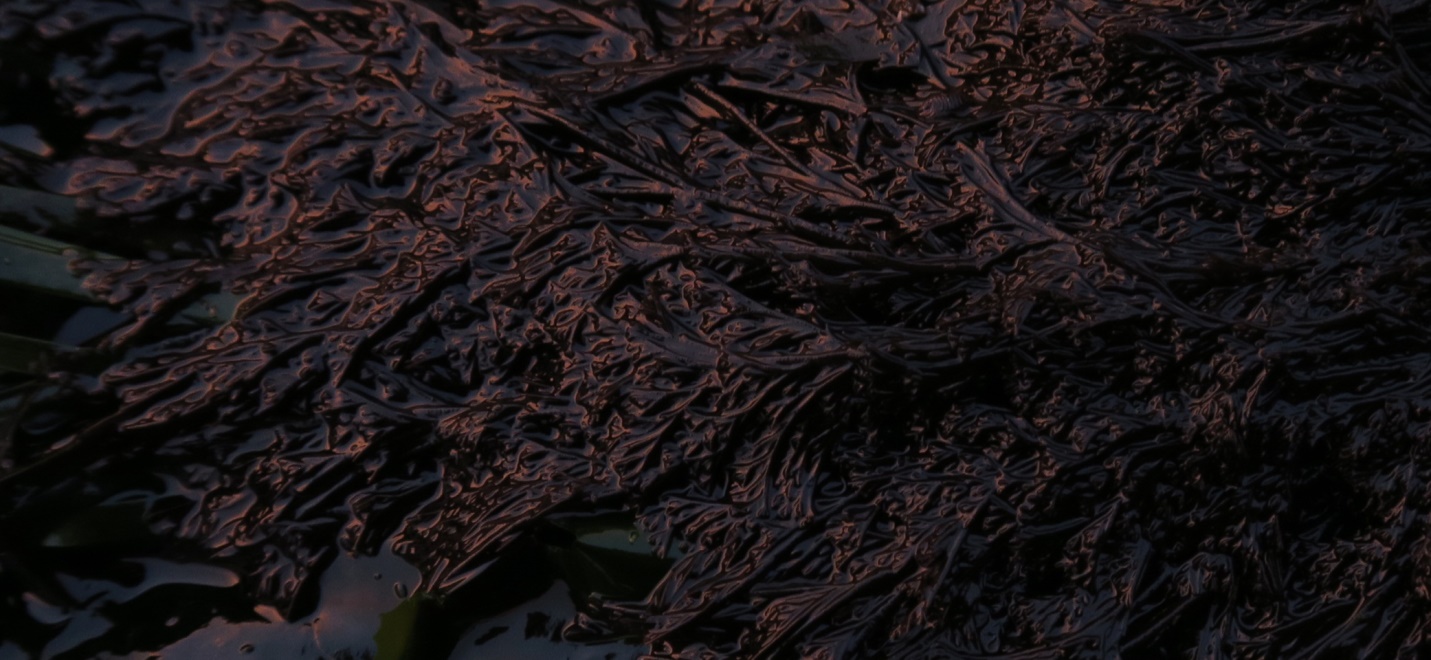
Figure 3: Microcladia borealis, Coarse Sea Lace, as viewed through the “darkened” camera setting – a technical ‘error’ that helped illustrate an important trait of this red alga; Harling Point, Juan de Fuca Strait, BC, Canada. September 27, 2020. Photo ID 27169 ©Seaweedwhisperings.com
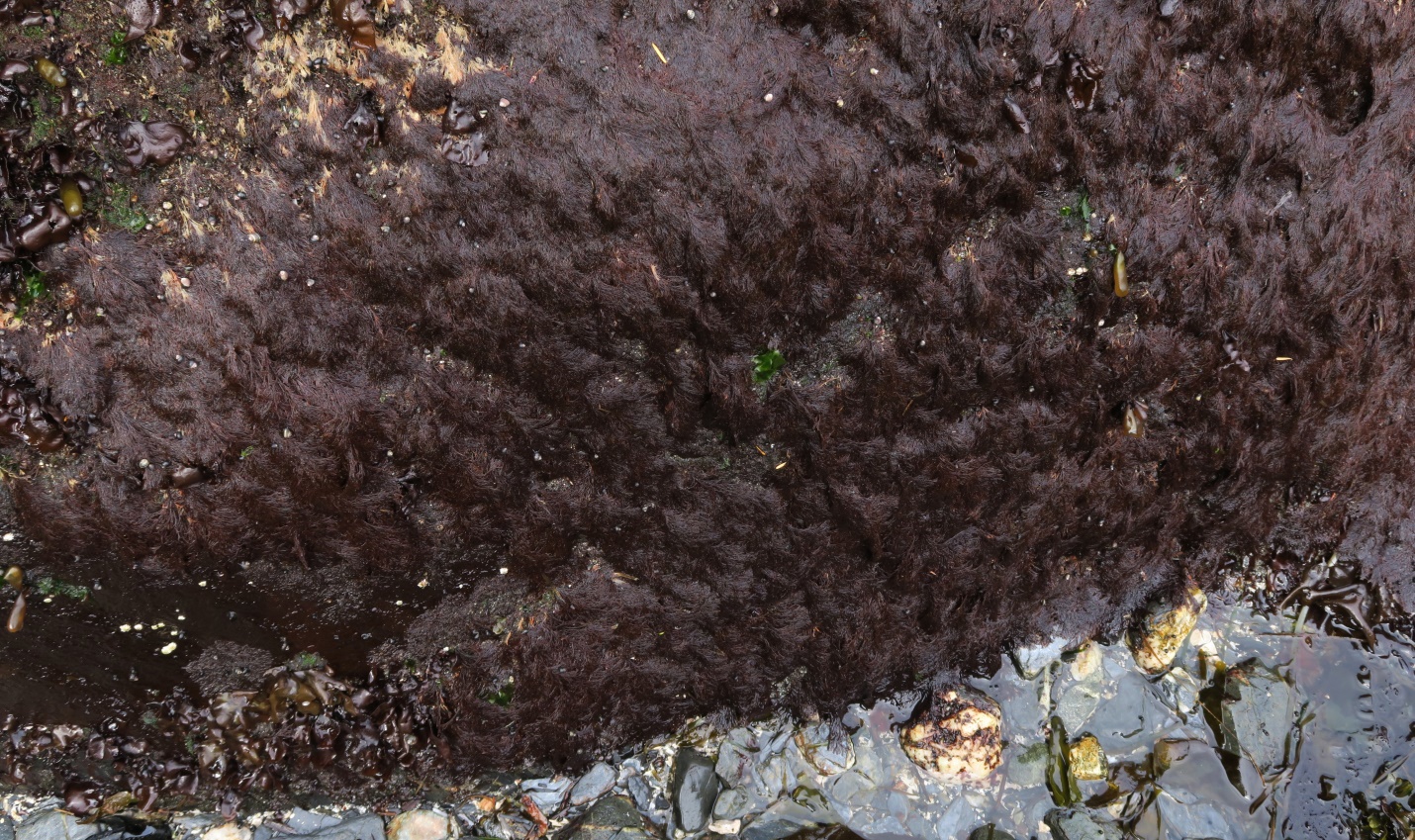
Figure 4: Microcladia borealis – multiple “fans” of Coarse Sea Lace blanket the surface of a nearly vertical rock face; Port San Juan, Snuggery Cove, BC, Canada. June 10, 2020. Photo ID 27170 ©Seaweedwhisperings.com
Discussion:
Growing in grooves of the bedrock, constrained but thriving.
Grooves; “in the groove” – like someone listening to music that they know and enjoy. Perhaps needs the comfort of familiarity. An image came up of a young guy, around 20 years old, with a big headset on his ears, listening to music. This brought up, the next concept – oblivious of and oblivious to others.
When the mention of light having been accidentally blacked out of the camera, this linked to the oblivious quality – blacked out, not really engaged with the bigger picture.
How time passed during this interaction, it felt suspended – another word that fits is “timeless”. This seaweed can be out of step with others and with some measures of reality.
Thre is a “one-sided-ness” of being protective and resistant to change, not accepting of outside input. At the same time, this seaweed is radiating out behaviors and energy that are not appreciated or appealing to others. They don’t give much and they’re passive; Microcladia borealis is oblivious that to the concept that this may irritate and annoy others.
These individuals might be ‘loners’, happy in their “groove”, but they’re not like self-sufficient backwoods hermits. They’re opportunistic and live off the bounty of the surplus/effort of others.
Slow, the slowness is the slowness to accept and adapt. Like the perceived slow assimilation of nutrients, this energy can be slow to gather and truly take in the input that would help inform growth.
Resistant/impervious: compared to all the other seaweeds around, Microcladia borealis wasn’t predated. Every pincer was perfectly formed – it felt as if nothing much would bother it, at least on the physical plane. Also, being in your “groove” and oblivious could serve to protect from bombardment by some outside influences – they simply would overlook you.
Upon attempting to move this seaweed from its prostrate position, discomfort and a strong desire to retreat back to its familiar original position was noted. The sense was there is happiness in its narrow channel, in its “groove”, and thus there is no desire to change. This can look to an outsider very much like there is little or no initiative, and upon pondering this, we realized, it’s not just a look, there really is low motivation here.
This seaweed is strong and tough, to a point, but it has no flexibility and when pushed too far, it snaps. Snap is another notable feature of this seaweed’s energy. If anything is given out, it is as if little bits “snap off” – outsiders receive only a piece-meal picture from Microcladia. This leads to confusion and misunderstanding. You might think the receiver would be curious, having only been fed small bits, but they soon leave it well enough alone, because not only is Microcladia thrifty in its sharing, its delivery can seem arrogant or insensitive, too.
Walking along the seashore before settling with the seaweed today, we passed a red rock crab: it definitely noticed our intrusion and was in full defensive mode with raised, open, menacing pincers held aloft. Microcladia borealis does have pincers, but they are not threatening looking. In fact they’re almost ‘pretty’ looking. Herein is the ‘trick/deception’ of this energy. It is easily perceived as being mean and nasty when it really knows that it is not. It may be stealing from others, but it is not doing so with malicious intent – it’s simply its natural way of being.
Is this behavior then amoral?
Do they not feel what they do is wrong?
Is it then that their code of life is measured in a different way? There is some measuring, some comparing, but it doesn’t translate because there is a clash with commonly held values.
This thievery is not really devious or premeditated, it’s more opportunistic. “If you leave it lying around, well, I may just pick it up for myself.”
Tiny pincers can only “take” wee bits. They aren’t going to inflict a huge single loss or pain. However, there are many of these pincers, so staying nearby, well, it would be almost like a death by a thousand cuts – you’ll keep getting cut/burned/used/irritated/taken from by Microcladia borealis energy.
They do best and feel contentedly “all’s well with the world” when living in association with others who create excess/surplus. So, they’re like a commensal feeder; they dine on the leftovers.
“Smugness” is also present here – like remoras who dine on the leftovers of a shark kill. “Look at me, I didn’t have to do any work, and I’m having a feast!” Smug! Content!
They’re not parasitic, but they do depend on this association with a pro-active and successful other, or group where abundance is generated. Those exposed to the Microcladia “commensal dependency” can often feel the desire to shake off the irritation, to escape the constant ‘one sided’ feeling to this relationship. Are they missing something about Microcladia, too, that their irritation doesn’t let them see past?
Relating to oneself is where the comfort zone is for Coarse Sea Lace; relating with others is unsettling. It inevitably brings up all kinds of discomfort, unhappiness, discord and misunderstanding.
The word “fan” is an apt description of the physical shape of this seaweeds growth habit. As a noun, fan fits well, but it also is true that this word fits as a verb. To “stir up” or “incite” or “inflame” are strikingly suitable for describing the response from/interaction with others as this seaweed radiates its natural manner of being. Being “stirred up” within, is also a difficult thing for Microcladia borealis to experience. There is a preference for entropy – energy is reserved and not available for ‘work’. There is a preference for having things roll off unnoticed “like water on a duck’s back”, but as Microcladia interacts with others, this is not the common experience.
This seaweed has a tough outer surface, one that is a surprising contrast to the delicate look of the alga. This physical feature extends to the character or ‘personality’; there is a barrier, toughened up on the exterior, because in the interior regions much vulnerability exists. And it’s not a type of naïve vulnerability. No, many hurts have been experienced before, and there is very little power to navigate through pain and back to openheartedness again. Intellectually there is cleverness; they can still tap some internal well of power with thoughts and ideas. Emotionally, though, there is weakness; they have no gumption, they have lost the resourcefulness to face challenges of the heart. So, the “groove” is sought and so very much valued – it is easy to lie back in the groove, alone, yes, but also safe and secure from hurt.
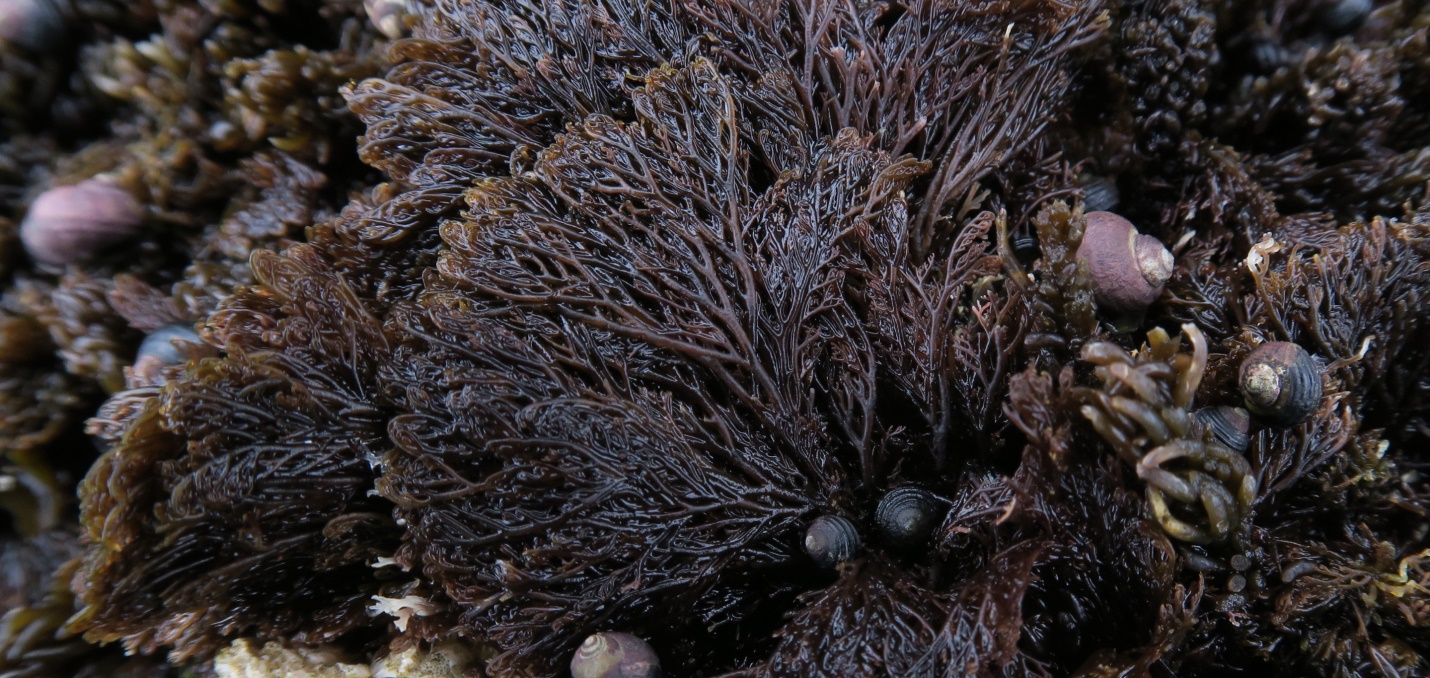
Figure 5: Closer view depicts the “lacy fan” quality of Coarse Sea Lace; Port San Juan, Snuggery Cove, BC, Canada. June 10, 2020. Photo ID 27171 ©Seaweedwhisperings.com
Leaving the seashore:
This morning, during our time here, the sea and shoreline was unusually overflowing with diversity and abundance of life. Notably so! Frist there was a gorgeous sunrise, then there was a single rainbow that grew into a double rainbow. We had visits from sea lions, seals, black oyster catchers, harlequin ducks, crows, mosquitos, wasps, pipits, gold finches, gulls and cormorants. Natural abundance and the energy of “plenty” were plainly evident during our whole stay. Need or want or stress was absent completely.
We later thought back to those 102 minutes at the seashore and said to ourselves, “It was ‘magical’ at Harling Point this morning.” There was an energy of gentle synchronicity. For example, we went down in the early morning light, knowing (as we always do check) both the timing of the approaching low tide and, as has become necessary in these shorter autumn days, the time of sunrise. The moment in time when we settled with our seaweed to interact was 7:07am – although not a deliberate choice, this was also the exact moment of sunrise.
Abundance and synchronicity…, Microcladia borealis has a relationship with them both.
Biology & Natural History Information:
Habitat: Abundant on rocks in the high to mid-intertidal (but low intertidal to subtidal in southern portion of its distribution) and also epiphytic on various kelps.
North Pacific Distribution: Aleutian Is., Alaska, to San Luis Obispo County, California.
Description: A delicate and profusely branched red seaweed, Coarse Sea Lace has filaments which are corticated by small cells or rhizoids. The axes of this seaweed are about 1mm in diameter and up to 20 cm tall, however most specimens are only 10 to 15cm high. The thallus can appear olive gray to brownish red or dark red and attaches to the substrate by prostrate rhizomoidal branches. Lateral branches are distinctly arched and carry successive orders of branchlets only along their upper side. These occur in the upper two thirds of the stem while the lower third is almost naked. The ultimate branchlets have forked tips that some authors describe as being shaped like tiny crab pincers.
Male and female gametophytes are separate individuals. Tetrasporangia occur on the slightly inflated tips of the branchlets and are usually crowded together.
Coarse Sea Lace prefers to grow on rocks that are somewhat to very exposed to surf. It has been found in association with Sea Palm, Postelsia palmaeformis, which enjoys this same habitat, and sometimes grows epiphytically on the surfaces of other species of algae.
Cortication, possession of a tough outer layer, is a structural defence against herbivores. In general this defense is thought to work best against herbivorous fish and sea urchins, and to be somewhat less successful against smaller herbivores such as amphipods, limpets, chitons and snails.
Classification:
Phylum: Rhodophyta
Class: Florideophysceae
Order: Ceramiales
Family: Ceramiaceae
Genus: Microcladia
Species: Microcladia borealis Ruprecht 1850
Previous names & synonyms: None
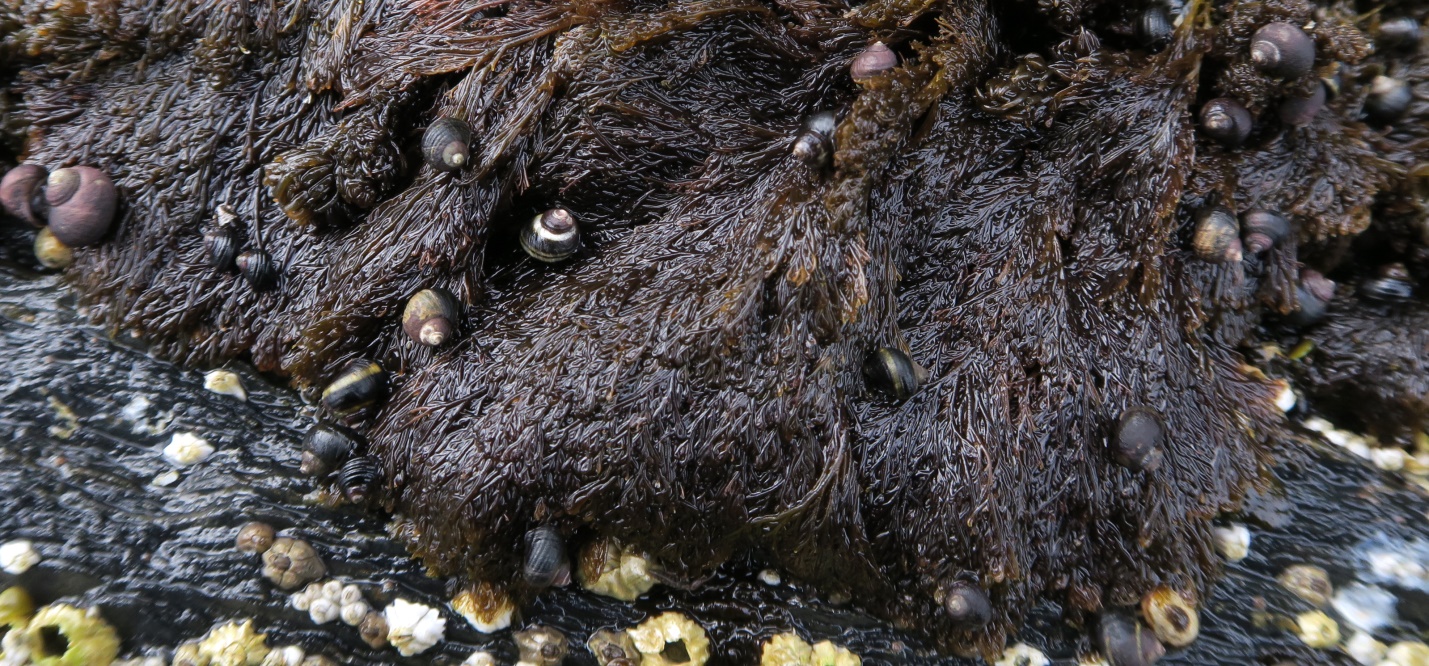
Figure 6: Microcladia borealis, cortication defence can be quite effective. Periwinkle snails appear to enjoy “dining out” on this grouping of Coarse Sea Lace, however a closer inspection revealed that the snails preferred to munch on the Black Pine, Neorhodomela larix, seaweed that is growing alongside and intermixed with Microcladia; Port San Juan, Snuggery Cove, BC, Canada. June 10, 2020. Photo ID 27172 ©Seaweedwhisperings.com
![]()